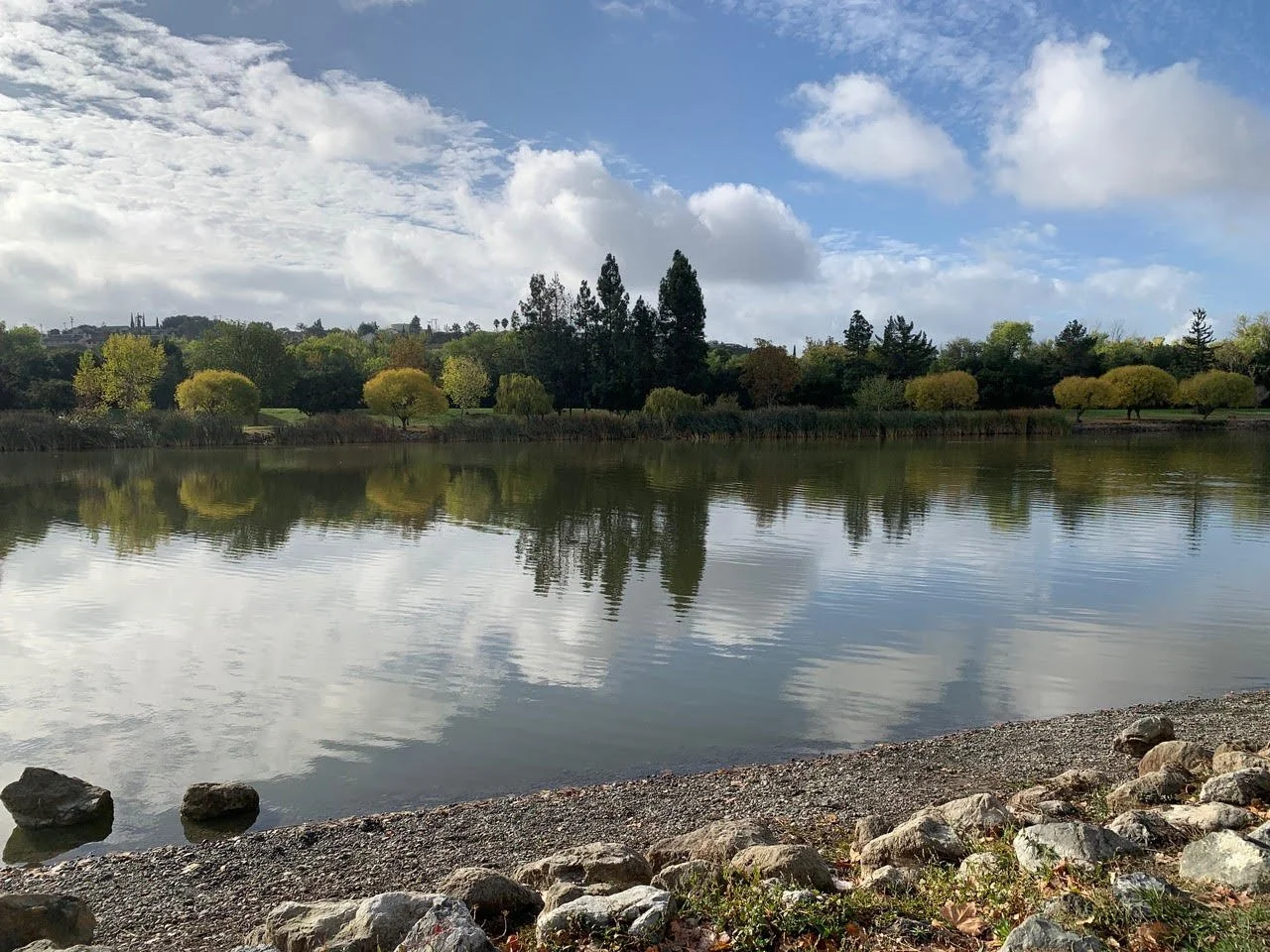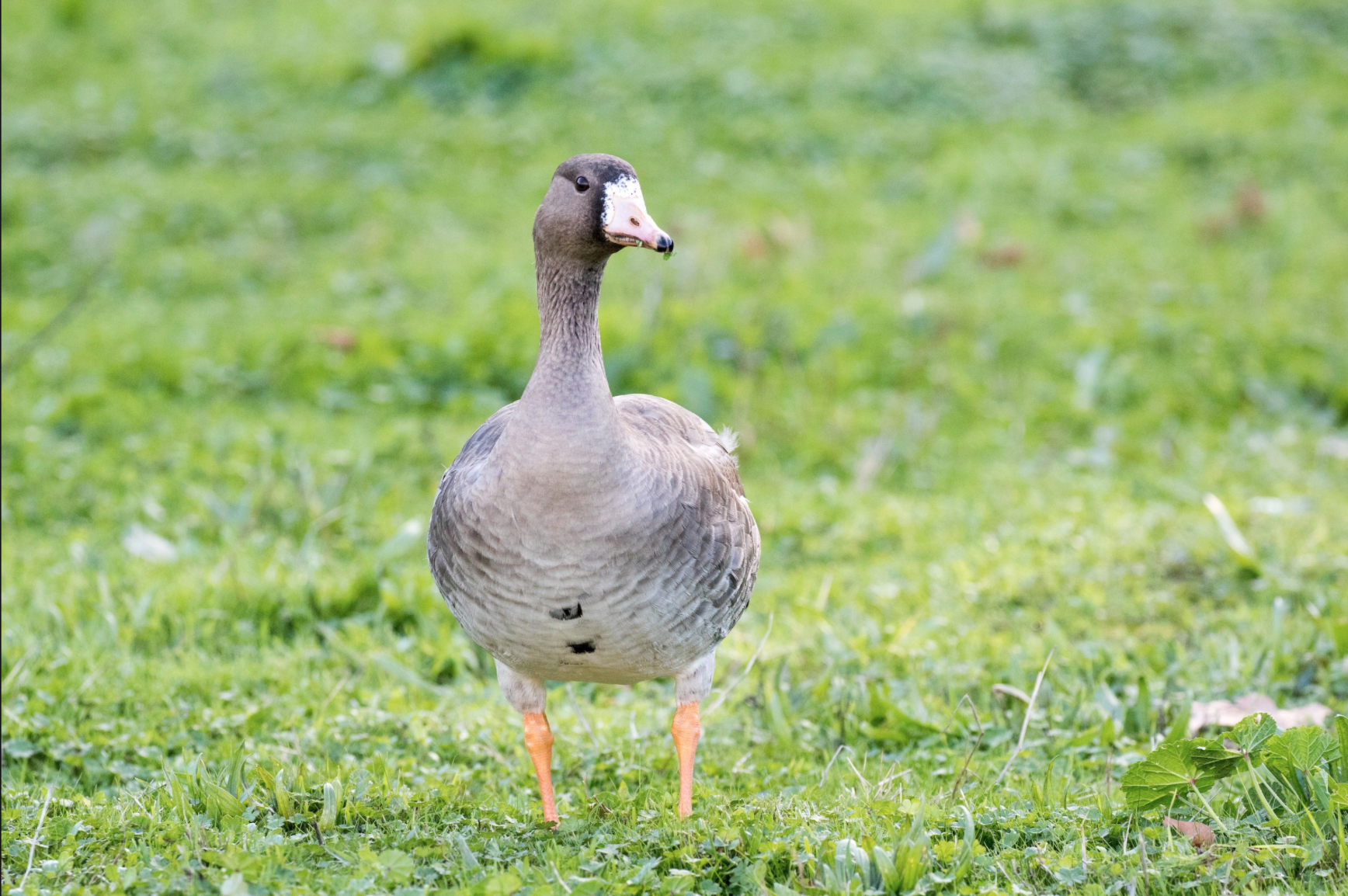Hellyer County Park (Winter):
Take a Gander at these Geese!
by Eve Meier
The highlight of this urban San Jose park is scouring through the hundreds of Canada Geese that cover the lake and lawn areas in hopes of finding a Cackling, Greater White-fronted or even a Snow or Ross’s Goose. Start this trip in the late morning after the geese have flown in.
Trip Covers: Nov - Jan
Key Birds: Greater White-fronted Goose, Cackling Goose, Yellow-rumped Warbler
How to Bird
Hellyer County Park is an urban park in San Jose that sits alongside Coyote Creek and the paved multi-use Coyote Creek Trail. This park includes the man-made Cottonwood Lake, which is open to fishing, a very nice playground, several picnic areas and a velodrome. The large lawn areas are shaded by oak, redwood, cottonwood and sycamore trees. Expect some crowds on the weekends.
View of Cottonwood Lake and Cottonwood Lake Loop Trail. Photo by Eve Meier.
On this trip, you will visit the south side of Hellyer Park and make a clockwise 1-mile loop around Cottonwood Lake using the Cottonwood Lake Loop Trail. This paved trail has no elevation gain but can be uneven in some spots. If you would like to extend your walk, you can make your loop slightly longer by using the Coyote Creek Trail and the Cottonwood Turf Loop Trail (see map).
I recommend starting in the late morning. If you start too early, you may not see any geese because these birds spend their evenings elsewhere (don’t ask me where). From my personal observations, the birds start flying-in about 10 a.m. in small groups of 10-20 at a time. Watching this process can be fun because you can start when there are no geese on the lake, but within the time of your walk around the lake, hundreds of geese will have arrived.
Because the highlight of this location is the geese, I like to focus on those birds first. Park in the playground parking lot (shown on interactive map) and head towards the lake which is within eyesight. You should see some of the geese right away on the lake and on most of the surrounding lawn areas. They are mostly Canada Geese, often numbering in the several hundreds. Among the hundreds of Canada Geese, there are usually a few Cackling Geese and sometimes Greater White-fronted Geese or even a Snow or Ross’s Goose (both rare). Scan through the geese looking and listening for something different like the orange legs of the Greater White-fronted Goose, the white of a Snow or Ross’s Goose, or a call that stands out from the typical Canada Goose honk that we all are so used to.
Cackling Goose (front) with Canada Goose (back). The Cackling Goose is about the size of a large duck. It has a short neck and smaller bill. Whenever I see these birds, the white cheek patch appears creamier to me than it does on the Canada Geese. There are a variety of subspecies, without and without the white neck-ring, best to read the details in your field guide. Photo by Brooke Miller.
Greater White-fronted Goose by Garrett Lau. The bill and legs are orange and, on adults, the front of the face is white. These geese are smaller than the Canada Geese.
The difference between the Snow (back) and Ross’s (front) is similar to the difference between the Canada and Cackling. The Ross’s Goose is smaller with a smaller bill, rounder head and shorter neck. Check your field guide for more field marks. Photo by Michael Mammoser.
Don’t let the domestic white geese fool you, there’s several at this park. Photo by Eve Meier.
After having fun gandering at all those geese, scan the lake for other birds. There will be hundreds of American Coots on and around the lake that are rather used to people. It’s a good time to check out their spectacular feet and note that they are lobed, not webbed like a duck. In fact, American Coots are not ducks, but are members of the rail family. To learn more about these birds, read Audubon’s Better Know a Bird: The American Coot and Its Wonderfully Weird Feet or watch SFBBO’s speaker series Reconsider the Coot: The Crazy Reproductive Antics of a Common Marsh Denizen by Dr. Bruce Lyon, UC Santa Cruz Professor.
This crazy colorful American Coot foot is perfect for walking on land and pushing through water. Photo by Vicki Robinson.
Besides the geese and the coots, also notice the ducks. Ruddy Ducks, Buffleheads, Canvasbacks and Ring-necked Ducks are common here. Sometimes the lake is also good for gulls. Find a bench with a good view and pull out your field guide to help you make out the different species. You should be able to pick out some California, Herring and Ring-billed Gulls.
You may see a lot of discarded fishing supplies along the lake. Did you know that fishing line, weights and hooks that are caught in vegetation, lost in the water, or left behind on the bank pose hazards to birds. See how you can help, read “Fishing Line: Don’t Catch a Bird!”
Now that you are done scanning the lake for the geese, ducks and gulls, you can start your clockwise route around the lake. Of course, along the way, continue to check out each group of geese in hopes of finding the more uncommon species.
There are a variety of trees such as cottonwood, sycamore, redwood, pistache, peppertree and oak, in the lawn areas and I find a lot of songbird activity in these trees. The most noticeable songbirds this time of year are the large number of Yellow-rumped Warblers “chipping” from the tree tops. Watch for Western Bluebirds dropping onto the lawn from a low tree branch to catch an insect and notice the American Goldfinches quietly feeding on the sycamore seed pods then flying off with a bouncy, undulating flight. Look and listen for Oak Titmice, Hermit Thrushes, Ruby-crowned Kinglets and Hutton’s Vireos amongst the tree leaves too.
One of the many large lawn areas at Hellyer County Park. Photo by Eve Meier.
During your walk, don’t forget to check the tree trunks and larger branches for White-breasted Nuthatches moving up, down and all around. And, look for the shy Red-breasted Sapsuckers that like to sneak around to the backside of a peppertree trunk or branch if they see you approach.
In the grass of the lawns, look for White-crowned and Golden-crowned Sparrows. When you see a large group of sparrows, take a moment to look at each bird. You might be surprised by a White-throated or Chipping Sparrow mixed in. Killdeers also enjoy the large lawn areas and they can be easier to spot when they are calling “kill deer, kill deer”.
View of the ridge to the east where the Tule Elk are often grazing. Photo by Eve Meier.
As you near the end of your loop around the lake and make your way back to the playground parking lot, check out the ridge to your east. Sometimes Tule Elk are grazing on those hills. And, you can often spot Red-tailed Hawks and Turkey Vultures soaring above.
Ready for More? Try birding at the Velodrome Picnic Area; the large grassy area has lots of shade created by mature sycamore trees. You can also bird south along Coyote Creek Trail.
Interactive Map
Directions: From US-101 in San Jose, exit Hellyer Ave. Travel west on Hellyer Ave, making a left to stay on Hellyer Ave. Turn left into the park and follow the signs to the playground. Latitude/Longitude: 37.282426, -121.811661
Parking: Paved parking lot with ADA-complaint spots available.
Fees: Day-use parking fees. See the park website for more information.
Public Transportation: None available
Park and/or Trail Hours: Park hours are from 8 am to sunset and trail hours are sunrise to sunset.
Facilities: Several wheelchair accessible bathrooms and benches along the route, picnic tables nearby.
Trip Mileage: 1 mile
Trail Conditions: Asphalt trails, no elevation gain but some uneven surfaces.
Accessibility: This trip is accessible with paved trails, lots of benches, and a wheelchair accessible bathroom at the trip start.
Bikes: Bikes are allowed but not recommended for this trip.
Dogs: Dogs are allowed on 6-ft leash.
More Information
eBird hotspot: Hellyer County Park
SFBBO’s Speaker Series: Reconsider the Coot: The Crazy Reproductive Antics of a Common Marsh Denizen by Dr. Bruce Lyon, UC Santa Cruz Professor
National Audubon’s Better Know a Bird: The American Coot and Its Wonderfully Weird Feet
More Resources
For more trips like this one, visit Self-Guided Field Trips.
Visit the SCVAS Birding Resources page for more information on where to bird, our birding community, bird identification resources and more.
Read “What to Look for Now” by SCVAS Executive Director Matthew Dodder.
Banner Photo Credit: Cottonwood Lake by Eve Meier
Last Updated: 5/21/2022
Enjoyed this Trip?
Support the work of Santa Clara Valley Bird Alliance and become a member. To contact the trip writer with comments, questions or location updates, please email fieldtrips@scvbirdalliance.org. You can also post in the comment section below. (If you’d like to post anonymously, type your comment, select “Post Comment”, then simply provide a name, like “Guest”, and select “Comment as Guest”.)









